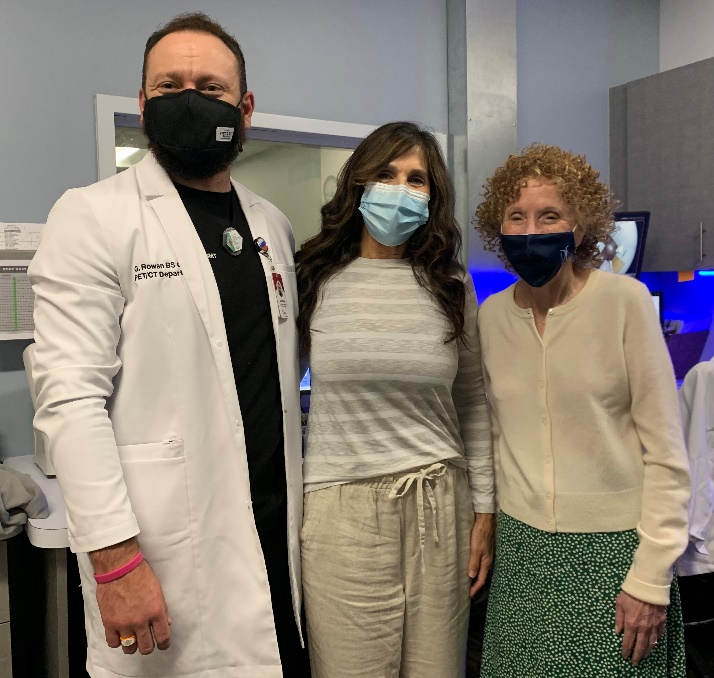Alexandra Spinner is a personal trainer in Beverly Hills, California, and a member of the Hollywood elite, being the daughter of a famed TV and film producer. She began having pain in her neck in the summer of 2019 and initially attributed it to a new weight-lifting program. But even after visits to her chiropractor and a round of anti-inflammatory drugs, the pain persisted; it was so bad, she could barely lift her head. An X-ray at urgent care found nothing, and finally she went to the emergency department (ED). “Spiritually,” she says now, “I had the feeling I was dying.”
The ED doctor ordered a series of scans (CT and MRI) and found the cause of the pain in Spinner’s neck: a tumor in her C2 vertebra (the second vertebra of the spine), which had caused a fracture. If Spinner had waited to seek an evaluation, the tumor could have caused a spinal cord injury that might have potentially ended her life. An emergency cervical fusion surgery was performed. Several months later, during a vertebrectomy, doctors were able to take another sample of the tumor and confirm that it was cancerous.
Another series of scans found two small tumors in Spinner’s left breast. The oncologist theorized that one of these was the source of the neck tumor: In a series of ongoing misfortunes, the cancer in her breast had traveled to another area in her body, giving her a diagnosis of stage 4 metastatic breast cancer.
Why had no one noticed this until now? Spinner, who was 58 at the time of her diagnosis, wasn’t at high risk for breast cancer — she was a professional athlete on a regimented diet with no family history — and received regular mammograms. But she also had dense breast tissue, which in her case may have made her breast cancer more difficult to detect.
A course of radiation treatment for the neck tumor and resection with lumpectomy for the breast tumors was all part of the harrowing trauma she endured. Spinner also received additional fluorodeoxyglucose (FDG) positron emission tomography (PET) scans which seemed to show something near the site of her previous surgery. However, it was difficult for her medical oncologist to tell whether it was residual disease or postoperative changes — or, most importantly, how to treat it.
A year and a half into Spinner’s treatment, her oncologist, Dr. Paul LaPorte, learned about a new molecular imaging tool that he believed would be able to collect more accurate information, helping to finally end the constant uncertainty Spinner left about her future: a first-of-its-kind diagnostic biomarker distributed by GE Healthcare called Cerianna (fluoroestradiol). Cerianna is a radioactive diagnostic agent that is able to provide the doctor with a “whole-body” picture of estrogen receptor (ER)–positive lesions in patients with recurrent or metastatic breast cancer and makes them visible on the PET scan image.
Spinner’s first Cerianna scan was positive at the area of concern in her cervical spine, confirming ER-positive disease was present in too delicate a position to be removed surgically.
However, the Cerianna scans also revealed that there was still no evidence of additional areas of ER-positive disease outside of the cervical lesion. LaPorte realized that her cancer was not acting like an aggressive type. He decided that chemotherapy would have been too extreme a solution for a single tumor that didn’t seem to be growing.
In the end, he decided on a gentler treatment: putting Spinner on endocrine therapy, adjusting her medications, and continuing to monitor the situation through regular Cerianna scans, five of them to date.
Spinner is disappointed that, at least for now, she’s going to have to live with the tumor. She’s heard about other patients who have been able to have normal lives thanks to information their doctors learned from Cerianna scans. In her case, the tumor has made it impossible for her to go back to work as a trainer and participate in sports like equestrian jumping and weight lifting. Still, she knows she’s lucky: she says a gratitude prayer every morning that she is still able to consult with clients, hasn’t had to go through chemo and got to keep her breasts.
“From the FDG PET scans, we didn’t know if we were doing the right thing,” she says. “But the Cerianna PET scan was the game changer. I lit up like a Christmas tree; my ER-positive status confirmed we were on the right path conclusively and helped to justify my physician’s treatment decisions.”
Now she’s learning how to live with her tumor. “Nobody’s more surprised than me that I’m here in one piece,” she says. Though family and friends have been there for her surgeries, she’s had to go to most of her doctor appointments alone because of the COVID-19 pandemic. She’s made a point of showing up with her hair done and in full makeup. She carefully schedules her phone calls to conserve her energy. After her first surgery, she started taking meditative walks when she feels she’s falling into a dark place. She also started seeing a trauma therapist and does vinyasa yoga.
Most of all, she’s been inspired by Deborah James, the British journalist who, before her death last summer at age 40, told her own cancer story on a podcast and on social media under the handle Bowel Babe and raised millions of dollars for cancer research. “She was blatant with her diagnosis,” Spinner says. “She had beauty and joy and enthusiasm and humor. She is my inspiration for setting forth with a renewed mindset and striving to become more of an activist for women with metastatic breast cancer and increasing access to better diagnostics and treatments.”
* * *
Disclaimer: This story is specific and may not be the case for every patient.
Important Safety Information
CERIANNATM (fluoroestradiol F18) injection is a diagnostic imaging agent (sometimes called a radiopharmaceutical or tracer). CERIANNA is used as part of a positron emission tomography (PET) scan for women to detect a specific protein called the estrogen receptor on breast cancer tumors that have recurred or spread from their original site (metastasized). CERIANNA is used in addition to biopsy.
Adverse reactions: The most common side effects seen with CERIANNA were pain at the site of injection and temporary altered taste sensation.
Radiation risks: CERIANNA is radioactive, and exposure to radiation has a dose-dependent increased risk of cancer. Please discuss with your doctor about ways to help minimize this risk.
Risk of misdiagnosis: CERIANNA imaging results can have false negatives and false positives. Please discuss any concerns with your doctor.
Use in specific populations: Tell your doctor if you are or may be pregnant; if you plan on becoming pregnant; or you are currently breastfeeding.
Additionally, CERIANNA has not been studied in patients under the age of 18.
CERIANNA is expected to behave similarly in adult patients, regardless of age.
To report SUSPECTED ADVERSE REACTIONS, contact Zionexa US Corp, a GE Healthcare Company, at 800-654-0118 or the FDA at 800-FDA-1088 or www.fda.gov/medwatch.




